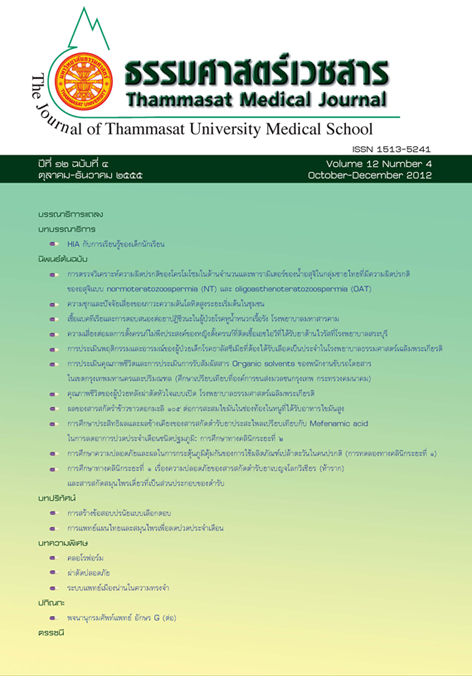Evaluation of quality of life and exposure to organic solvents among bus drivers in Bangkok, Metropolis and domain (Comparative study in Bangkok mass transit authority, Ministry of transport)
Keywords:
Toluene, Xylene, Organic solvents, Quality of life, Bus driversAbstract
Objective: To evaluate organic solvents exposure and quality of life among bus drivers (ordinary bus drivers andair condition bus drivers).
Method: This research was a cross sectional analysis. The samples were 151 persons; 100 cases of ordinarybus drivers and air condition bus drivers and 51 controls of offi ce workers. The assessment tools were asfollows: questionnaires inquiring about demographic data, quality of life and in collecting the air samplesa personal “Organic vapor monitor (3M 3500)” were attached to breathing zone of the sample groups.
Results: Mean age was 46.30 years for ordinary bus drivers and 48.82 years for air condition bus drivers, mean ageof controlled offi ce workers was 35.67 years. Ordinary bus drivers and air condition bus drivers workedat least 10 hours per day and used respiratory protection all time of wore about 18% and 2%,respectively, however most of them used only cotton masks. Most of the study groups had moderatelevel of score of quality of life (80.0% for ordinary bus drivers and 84.0% for air condition busdrivers). Results of ordinary bus drivers and air condition bus drivers showed average ± SD measures oftoluene 243.86 ± 241.85 μg/m3, 270.66 ± 240.04 μg/m3, respectively and xylene 715.25 ± 459.02 μg/m3,591.58 ± 425.96 μg/m3, respectively. The average comparison of toluene and xylene were signifi cantlydifferent between the study and control groups at level 0.001 (p < 0.001). Urine samples were collectedafter the work shift. Average urine hippuric acid level of ordinary bus drivers and air condition bus driverswere 276.69 ± 344.17 mg/g creatinine and 276.30 ± 323.15 mg/g creatinine, respectively and theirurine methyl hippuric acid level were 11.72 ± 27.00 mg/g creatinine and 3.86 ± 12.00 mg/g creatinine,respectively. The average urine level of hippuric acid was signifi cantly different between the study andcontrol groups at level 0.001 (p<0.001).
Conclusion: The ordinary bus drivers and air condition bus drivers had exposed to organic solvents while working andthere should be organizing the training in order to gain the knowledge and understanding the hazardand the protection including the use of the correct and suitable respiration protective equipment.
Key words: Toluene, Xylene, Organic solvents, Quality of life, Bus drivers


